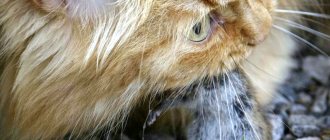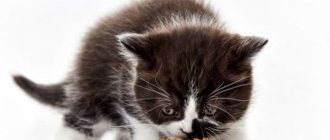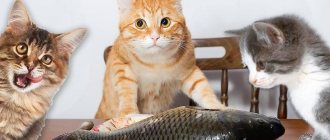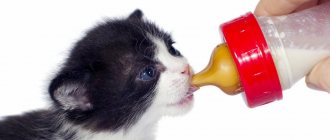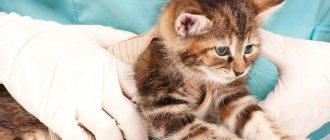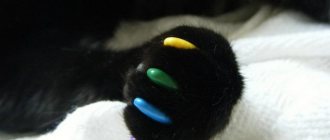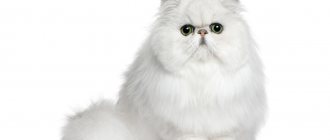Many veterinarians do not recommend giving chicken bones to a cat, much less a small kitten. Although in the wild, representatives of the cat family often hunt, including birds, it is still not recommended for pets to eat tubular bone. This is due to the fact that after a pet has eaten such food, it may vomit, and the sharp edges of the bone can damage the mucous membrane and cause bleeding and other complications. But it is still sometimes possible to occasionally treat kittens and adult cats, but you need to know how to give bones correctly.
Is it possible to give?
Experts have 2 opposing opinions on whether pets should be allowed to eat chicken necks and other bones. Some believe that a cat should not be given such dishes, since there is a high risk of injury to the mucous membrane of internal organs. Others believe that for the healthy development of the cat's body, kittens and adults need to eat bones, which contain useful components.
Veterinarians focus the attention of cat owners on the fact that only the cartilaginous bones of broiler chickens are allowed to feed the pet, while it is strictly forbidden to feed the cat chicken heads and feed raw chicken, which can lead to serious health problems.
Green light for the chicken!
So, chicken can be given to kittens and adult cats almost every day, but not fried, but boiled and definitely WITHOUT bones, especially if it is a small kitten. At 3.5 months, when the baby has grown enough and his teeth have become stronger, you can start feeding him with chicken legs, and by one year - with chicken heads. But it is better to take the heads of young hens or chicks, they are more tender, their bones are soft, and it is convenient for cats to chew them. It is better to boil both the legs and heads thoroughly so that they become soft. Of course, cats need to be given raw meat sometimes, but not chicken because there is a risk of salmonella infection.
It is best to feed kittens chicken breast - soft meat and without bones. You can give boiled chicken by-products - heart, lungs, kidneys, liver. It should be noted that cats adore liver almost as much as fish, only experts and veterinarians do not advise getting carried away with it (they recommend no more than once a week), because the liver, as is known, is the body’s filter, including in animals, and therefore the coat may become coarser, and in light-haired pets the color may darken. Adult cats and small kittens don’t really like lungs and kidneys; they don’t really eat them. The heart is given 1-3 times a week.
A good option is to grind boiled chicken through a meat grinder and make a kind of minced chicken that can be given to kittens along with broth. This will make it more convenient and easier for the kitten to eat.
Why can't a cat eat bones?
Sometimes fragments of such food can get stuck between the animal's teeth.
If a cat ate chicken paws or other bones once, then perhaps nothing bad will happen, but when an animal constantly eats broken chicken bones, serious health problems are possible. The seed does not have any nutritional value, but contains many useful microelements. This is the only benefit to feeding your cat chicken bones. In most cases, such a component in a cat’s diet can have dangerous consequences, even if the bones are boiled or made into bone mince. Such a diet threatens the following disorders:
- mechanical damage to the mucous membrane of the mouth, esophagus, stomach or intestines;
- hard pieces getting stuck between the teeth, which leads to gum injury;
- blockage of the digestive tract.
Tubular bones and chicken feet pose a particular danger to a cat's health. This is due to the fact that such parts have sharp edges that severely injure the mucous membrane. Spongy components are less dangerous, but can still provoke an inflammatory reaction or blockage of the esophagus. In the latter case, the cat exhibits the following unpleasant symptoms:
- constipation or diarrhea with blood in the stool;
- lethargic state;
- problems with appetite;
- repeated vomiting;
- copious amounts of saliva;
- pain during bowel movements.
By-products to increase calorie intake
Some parts of the carcass contain woefully little protein but are high in fat. And some, such as testes, are a source of protein and fat at the same time. Fatty by-products should not be given to cats with impaired liver or pancreas function, as well as animals prone to obesity. But they serve as an excellent energy boost, for example, for nursing cats or stud cats.
Testes (bovine, lamb)
Although the seeds are considered a delicacy in many cuisines around the world, they are quite difficult to find for sale. They don’t have to be included in your cat’s diet for it to be complete, but if the opportunity arises, be sure to let your pet try them.
Beef testes
The testes contain a lot of protein and fat, B vitamins and microelements (zinc, manganese, copper, nickel).
There is no need to be afraid of the hormones supposedly contained in the testicles. Their concentration in the testes is negligible, since all produced testosterone immediately enters the blood.
The testes are given raw or lightly boiled (7 minutes after boiling). Before giving them to a cat, remove the thick shell from the testicles and cut them into pieces. The norm is 5-10% of the diet, while it is permissible to feed the testes in a separate feeding, without mixing them with meat.
Beef udder
Udder is a cheap and nutritious product, but I recommend feeding it to cats with caution. The dry udder consists mainly of fat and rough connective tissue, which is difficult to digest. The milk udder has a more delicate consistency and a pleasant sweetish milky smell and taste. But cows are rarely slaughtered for meat during lactation without a good reason; usually these are sick animals. Therefore, the milk udder must be carefully checked for signs of mastitis (pus, inflamed areas).
The udder contains about 12% incomplete protein and 14% fat. It is given to cats in order to increase the calorie content of the diet, in an amount of no more than 5% of the total diet. This product is fed both raw and cooked (the broth after cooking is not used for feeding). The udder has a rubbery consistency, it is very difficult to chew or bite off a piece, so you need to cut it into convenient pieces in advance. The easiest way to cut a frozen product is to use a very sharp knife.
Brain
Beef brains can be difficult to find commercially because they are perishable. But if you give your cat chicken heads, then when she eats them, she also gets brains. The value of brains lies in the fats they contain. These are omega fatty acids, lecithins and cholesterol. The brain also contains a lot of choline (B4).
Beef brains, if you were able to buy them, are not fed in their pure form, but are added to the meat mixture. The high fat content of this offal causes severe diarrhea in cats if the dosage is overdone. Brains are given in the amount of 2% of the total diet. They can be especially useful for cats exhausted by pregnancy and lactation, as they increase the calorie content of food.
What's the best way to give?
It is not advisable to treat your pet to boiled parts of a bird's skeleton.
If, nevertheless, the owner prefers to feed the cat chicken breast or other bones, then it is worth knowing how to feed the animal with them correctly in order to reduce the risks of deviations and negative consequences. When feeding such products, adhere to the following recommendations:
- Completely exclude tubular bones from the cat’s diet, which, when the pet eats, break into sharp fragments that injure the mucous membranes.
- It is forbidden to feed boiled chicken, which becomes even harder. Due to heat treatment, bones are less digestible.
- Chicken skin, bone structures, legs and necks should be hammered or processed into minced meat before serving. In this case, it is necessary to remove hard parts such as beaks and others.
- For adult felines, it is necessary to feed no more than 5-10% of bones from the total diet. If there is a lot of such food, then there is a high probability of constipation or intestinal obstruction.
- Kittens and older animals should not consume such products, since their jaws are weaker and cannot always bite through hard pieces.
Although chicken bones contain a lot of calcium and phosphorus, their excess in a cat’s body is no less harmful than a deficiency.
Pork
Perhaps the most “ardent” prohibition regarding the feeding of all domestic animals is pork. To back it up, there are three compelling arguments why cats should not be fed pork:
Pork is most often fatty.
Source of helminths.
The source of false swine rabies (Aujeszky's disease) is a disease that is not dangerous to humans, so meat that goes on sale is not tested for the presence of the virus. An infected pet most often dies quickly.
This is a reasonable ban at first glance, but it contradicts a number of facts:
Lean boiled pork contains less fat and carbohydrates than rabbit meat, but is richer in protein.
Helminth eggs die at low or high temperatures, that is, if you cook or freeze pork for 3-4 days, it is safe.
Aujeszky's virus is killed by heat treatment.
For many animals with weak joints, it is recommended to boil pork cartilage and ears.
Conclusion: A blanket ban on pork is unwise and looks more like “reinsurance” than reasoned fact. However, cats do not like a lot of variety in their food, and if your pet is happy to eat chicken or beef, then pork can be excluded.
Substitute Products
You can treat your pet to boiled fish, but not often.
Veterinarians say that it is better for the cat to eat other foods that contain no less useful components instead of a chicken bone. You can replace bone mince with the following dishes:
- Fish. When a cat eats such a product, you should also carefully monitor it so that it does not choke on the bone. It is strictly forbidden to replace the main food with it; fish should only serve as an additive. It is allowed to feed your pet this dish 1-2 times a week, but it is allowed only in boiled form.
- Special bones. They consist of tendons and movable joints in crushed form, as well as beef stomachs.
It is best to give preference to specialized dry food for cats, which must be given to the animal in a certain dosage. This food is as balanced as possible, since it contains all the beneficial microelements in the quantities necessary for the cat’s body. When purchasing a product, the age and health of the pet are taken into account. It is equally important to read the composition of the product, because if it contains flavorings, preservatives and salt, then you should not choose such dry food. It is important for the owner to understand that only premium and super-premium products will be useful. If your cat still wants to eat chicken bones, then you should give them with leftover meat and cartilage. In this case, the pet will satisfy its hunting urges and will not cause harm to the body.
Meat intolerance
Meat treats for cats are quite weighty and tempting products that are 90% digestible. Most owners stop feeding their cats raw meat due to poor tolerance. The animal may experience an upset stomach or an urge to eat. This does not mean at all that it is a dangerous and incompatible food product for cats. Here we should focus on the potential capabilities of the digestive tract, the stomach, where hard or lumpy food is digested. Typically, in such situations, cats may have a reduced level of acidity of digestive juice, and an inflammatory disease of the stomach may develop.
The stomach stops coping with certain loads. The digestive organ can no longer cope with raw meat even if you constantly give the animal boiled food and ready-made food. require a different process for implementing the functions of the digestive glands, pancreas and gastrointestinal mucosa.
Boiled chicken bones won't do any good for cats.
, they are poorly digested and can cause. You can introduce small amounts of cartilage into your diet. They will be more useful. To obtain additional minerals, it is better to use ready-made supplements.
Let's summarize the meat products prohibited for cats:
- Chicken bones and... Bones can damage the esophagus or stomach and clog the intestines.
- Pork, fatty lamb, goose, duck. These types of meat products are quite fatty and difficult for a cat to digest.
- Fatty, spicy, salty, smoked foods.
- Sausages, canned food.
- Fried foods.
Benefits of feeding cats raw meat
:
- Fast digestibility.
- The best complementary food for a kitten.
- During heat treatment, beneficial substances are boiled out of meat, especially taurine is lost.
- Boiled meat is less digestible.
It is known that the missing amount of taurine can be replenished with the help of special vitamins. But if done correctly, a pet can get everything it needs from meat products.
It is important to know which types of meat contain more taurine and other substances
You need to use different types of meat products all the time
, vegetables and cereals in order to diversify the natural diet of your pets as much as possible.
For them, feeding one type of offal, cereal, or constantly repeated other foods can result in a loss of important amino acids. And constant jumps from natural ingredients to industrial feeds can negatively affect the digestive system. If an animal eats meat, then its systems are configured to process tough food. If this is food, then it must be given out at the same time and of the same type.
If you combine two types of feeding, the digestive system will malfunction and stop working at full capacity. It is better to immediately decide when and what type of feeding you will begin to introduce to him.
Very often we feed our beloved pets “from the table” and do not think about the fact that this can harm them. What about raw meat? Can cats eat meat in any form?
Cats are “predators” by nature. So let’s create the right meat diet for our domestic animals! After all, for your pet to please you with good health and good appearance, proper nutrition is a prerequisite.
So, in order not to harm your pet, you need to figure out what kind of meat you can give and which one is better to refuse (as in the case).
Reference!
In the wild, where cats have to survive, they often eat meat. Namely mice and birds.
Chicken bones. Yes or no?
Most people believe that cats should not be given bones because:
- Firstly, they are not dogs and there is no need for them to scratch their teeth in this way.
- Secondly, the cat may choke on them, or simply will not be able to gnaw and chew them properly.
But do not forget that if you leave your cat without this treat, then most likely he will have problems with his teeth, since the animal will have a lack of calcium and phosphorus in the body.
Consider the option of permitted bones for cats and kittens:
- Chicken necks ground in a meat grinder.
- Large bones that a cat cannot chew and swallow.
- As well as special bones sold in pet stores.
But fish bones are not welcome, since due to their fragile and thin structure they can get stuck in the cat’s larynx or damage its stomach.
Feeding your pet should be balanced. Don't limit yourself to meat dishes only. If you decide to feed your pet not only dry food, then you should once again make sure that this will not harm him. Therefore, make sure that:
- The meat was not too fatty.
- Raw chicken is welcome, but if you want to play it safe, you can serve it cooked. It won't get any worse.
- Chicken bones are only neck bones and thoroughly ground in a meat grinder.
- You should not feed your cat chicken scraps or skin.
Still, if you decide not to give your pet bones, then make sure you get calcium and phosphorus from other food sources. The well-being and health of your pet's teeth is an important factor in the happy and carefree life of your pet.
